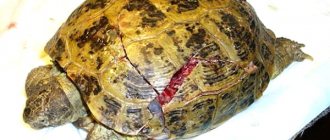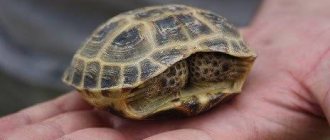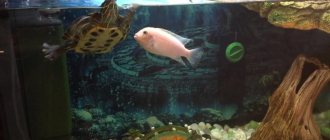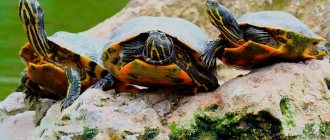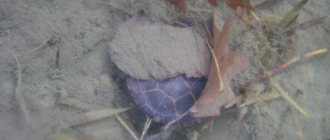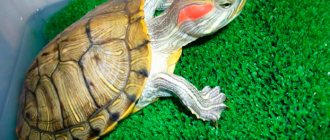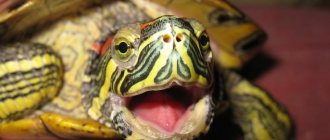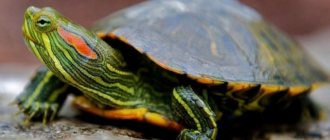Soft shell is a symptom of calcium and vitamin D3 deficiency
Often the presence of a softened shell in an amphibian is accompanied by some other symptoms: redness of the eyes, the appearance of small tubercles and swellings on the protective shell, increased body temperature, bending of the edges of the shell.
The above symptoms can be a consequence of many diseases, namely abnormal thyroid function and intestinal dysfunction. The hardness of a turtle shell is directly affected by the amount of calcium that circulates in the animal's body. It is with a deficiency of this element that deformation of the shell and other symptoms occur. A turtle in this condition cannot be left without treatment, otherwise over time its skull bones will become deformed and the animal will not be able to feed normally.
Calcium deficiency can be caused by a malfunction of the intestines or kidneys, as a result of which the rate of calcium absorption in the amphibian’s body is significantly reduced. Lack of ultraviolet radiation and, as a result, vitamin D deficiency can also lead to softening of the shell in a pet.
Diseases
Soft shell is a symptom of certain diseases:
Rickets
Diagnosing rickets in a turtle is quite easy. If you press on its shell with your finger, a hole will appear. Additional symptoms are bending of the edges of the carapace, the formation of tubercles on the shell, hyperemia of the mucous membranes of the eye, increased temperature, and tremor of the extremities. In advanced cases, the shell bends, taking on the shape of a dome or saddle, the head is deformed, the upper jaw becomes beak-like, and then delaminates, and the lower jaw becomes flexible. The bones become soft and elastic, which provokes frequent fractures.
Osteopenia
In sick animals, bone mass decreases and its density decreases.
There are 3 types of osteopenia: osteoporosis, osteomalacia, osteitis fibrocystis.
Osteoporosis
Minerals and organic matrix are lost due to protein deficiency. The vertebrae may become deformed.
Osteomalacia
Bone tissue is not sufficiently mineralized, causing bones to lose strength and become soft, leading to frequent fractures.
Osteitis fibrocystis, or hyperparathyroidism
The underlying bone substance is washed away and replaced by fibrous tissue. As a result, the bone becomes deformed and increases in size.
How to cure a pet?
If your turtle exhibits similar symptoms, you can try to take some measures yourself. In summer and warm spring, the pet can be taken out in an aquarium to the balcony or outside and placed in the sun. It is important that direct sunlight does not fall directly on the animal, but illuminates the aquarium well.
During cloudy seasons, in autumn and winter, an aquarium with a turtle should be placed under an ultraviolet lamp for a while, having previously covered the turtle’s eyes with a plaster. This must be done to ensure that radiation and bright light do not damage the organs of vision.
The turtle's diet should be reconsidered: you can add multivitamin complexes containing vitamin D and calcium to it. Shrimp can be a natural source of calcium for turtles. Hard-shell shellfish or minced fish with bones should be added to the animal’s diet.
But if the disease is in an advanced form or the measures taken have not brought the desired result, then the amphibian should be taken to a veterinarian. The doctor will administer a course of injections with vitamin complexes and the condition and appearance of the red-eared slider will improve significantly.
Description
The low carapace (carapace) is almost oval; if you look at it from above, you can see that the width in the back is slightly wider than in the front. The length of the shell is 20 cm or more in adult large turtles. Since water has always been the key habitat for turtles, the carapace scutes naturally fit perfectly together. In terms of their structure, the carapace and plastron are completely streamlined and have no protrusions. Large claws are located on the legs, small membranes are located between the toes. The claws of a swamp turtle can easily tear prey apart and can significantly scratch your hand. The tail of this turtle is relatively long, can reach 3/4 of the length of the carapace (about 12 cm) and during swimming it takes part as an auxiliary rudder during any turns (the main steering is carried out by the legs) and as a counterweight that holds the turtle in the required position during maneuvers. The carapace usually has a dark olive, dark green, sometimes almost black color, the plastron is light, yellowish. The shell, neck, head, legs are covered with small light spots. Often females have yellow eyes, while males are slightly reddish. Females have slightly shorter tails than males.
Preventive measures
The best way to prevent the development of the disease is its prevention. To prevent the red-eared turtle from starting to soften its shell, it is necessary to sunbathe the animal several times a week. A good way to prevent calcium deficiency is to add crushed eggshells to your turtle's daily food several times a week. In winter, when the days outside are cloudy, the turtle needs to be given a solution of vitamin D-3. 3 drops of vitamin D for an adult turtle 2 times a month will completely prevent the development of rickets. The vitamin injection can be given into lumps of food or injected into the animal’s mouth using a medical syringe.
Following the above recommendations is an easy way to keep your turtle healthy. However, if the softening of the shell has already begun, the necessary measures should be taken. After all, rickets, a softening of the shell, can lead to the death of the animal.
Pond slider
The taxonomy of the red-eared turtle species is very confusing. Their shell is relatively flat. The young of these reptiles have a light green tint to their shell; with age, its color changes to light brown or olive, then patterns appear on it that look like vertical yellow stripes, which are especially noticeable in water. Behind the eye of the red-eared turtle there is an elongated red spot. It is thanks to him that it owes its name. Stripes of white and light green colors are observed on the head, neck and limbs of the reptile.
Trionix Chinese, appearance
The length of the animal at home varies between 20-25 cm, but in rare cases it grows up to 40 cm. The weight of an adult can reach 4.5 kg. Not long ago, a turtle weighing 11 kg and a shell length of about 50 cm was caught near Taiwan, but this is already an anomaly.
The Trionix shell is round, the edges are soft, with age it changes shape from round to elongated; by this characteristic the age of the animal can be determined. The upper, visible part of the shell is green-gray or green-brown in color to camouflage itself at the bottom. The ventral part of the shell is much lighter, yellow, pink and orange. There may be dark spots - this is normal.
Shell color
Each paw has five toes, which end in three long, sharp claws. The shape of the foot has the characteristic features of waterfowl - the toes are connected by membranes.
The neck is very long; if you hold a turtle by its shell, it can stretch its neck and bite.
Tortoise flexibility
By nature, this is a solitary predator; you should not keep several individuals together at home. Fights with limbs being bitten off will be inevitable.
Subcutaneous administration of drugs
Medicines that are not characterized by an irritating effect are perfectly administered subcutaneously.
This process is carried out under the skin at the base of the shoulder or thigh on the medial side. If the leg extends without problems, then the medicine is administered in the area where the inguinal notch of the shell is covered, or in the area where the thigh ends. If this cannot be done, then the medicine is injected at the base of the shell, above the retracted paw. Moreover, the needle is not inserted deeply.
If the turtle is severely dehydrated, then it is not recommended to stab it in the area of the inguinal fossa, since the wall of the bladder may be at a close distance from the skin.
Types of fungi in children and treatment methods
A child’s skin is a thin and delicate covering that helps protect the body from infections and viruses, but due to its immaturity, increased level of vascularization and weak immune status, fungus often appears in children. A fragile body is not able to resist fungal diseases on its own, so conservative treatment under the supervision of a doctor is required. Let's find out what reasons lead to the development of the disease, how are fungal diseases diagnosed in children?
Symptoms in children are determined by the type of specific pathogen, its aggressiveness, the affected area and location, and the reactivity of the child’s body; accordingly, the clinical pictures vary significantly, as does subsequent treatment.
The causative agent of microsporia is the fungus Microsporum canis or M.ferrugeneum. Often affects children under 10 years of age. The disease is characterized by the formation of round lesions in the form of small papules that rise above the skin of the scalp. Within the localization, small gray or white scales are observed.
If microsporia is diagnosed on smooth skin, then the mother of her baby can observe concentrated red plaques, which are surrounded by a ridge of tiny bubbles and crusts.
School-age children may have lichen versicolor; its symptoms are as follows:
- On the back and chest (somewhat less commonly, the location is the abdomen, neck and lower limbs) flaky spots of irregular shape appear, tending to increase;
- The spots have different shades - cream, light brown, yellow. They do not tan when exposed to ultraviolet light - a secondary form of leucoderma appears.
Candidiasis affects the mucous membrane of the oral cavity, nasopharynx, and vagina (in girls). Mycosis of the oral cavity develops due to the growth and reproduction of fungi of the Candida family. Children are often diagnosed with yeast cheilitis - the lips turn red, swelling, intense peeling and yeast erosions in the corners of the mouth appear - the skin in the corners cracks, it hurts to open the mouth.
Diarrhea
Diarrhea is most often caused by poor or stale food. In addition, diarrhea may occur due to intestinal injury.
How do I recognize diarrhea?
Feces are mushy, runny, or have a strong odor.
It is necessary to limit food intake for a week. In this case, daily bathing is recommended, in addition, you need to make sure that the animal drinks a lot of water. It is necessary to control the turtle's weight; for this, it is recommended to weigh it regularly. If you do not see any improvement, contact your veterinarian immediately! In the absence of damage to internal organs, the prognosis is positive.
Why is this happening
During labor, even if it goes well, the newborn's head has to face a number of difficulties. Even an easy birth for the mother can be difficult for the baby: the baby walks head first, the bones of the mother’s pelvis, the muscles of the pelvic floor and the genital organs put pressure on his skull, so the delicate bones are subject to displacement.
It should be noted that the skull is not a single bone, it consists of many individual bones that are connected by sutures. The baby’s seams are still elastic, mobile, and not fully secured. This is what helps the bones of the skull move during childbirth, as if overlapping each other, changing the shape of the head and facilitating the birth process. This mechanism was invented by nature itself because the diameter of the newborn’s skull is larger than the diameter of the mother’s birth canal. After birth, the bones of the skull normally “straighten.” The head regains its normal shape.
Arrangement of the aquarium
Maintenance and care do not require a special approach, but you should always remember that turtles of this subspecies can grow up to 20 cm or more in length. Therefore, when arranging a home, this factor should be taken into account so that the turtle does not feel crowded. In this case, take an aquarium that is not tall and not wide, but long enough so that the space can be divided into two parts.
Despite the fact that this species of turtles (yellow-eared and red-eared) are related to aquatic ones, the turtle definitely needs land. You can organize the land in any available way: put a large stone on the bottom of the aquarium so that it looks out from the water or add some soil. In short, the main thing is that the land is above the water level, and the turtle can easily climb onto it. If there is enough space in the aquarium, then you can add soil and plant suitable plants, then the turtle will feel just like in natural conditions. In this case, there is a huge space for the flight of your imagination.
Soft shell of sea turtles
This type of reptile is distinguished by a teardrop-shaped shell. This shape allows the pet to swim quickly. If it suddenly becomes pliable and soft, it means the owner has violated the conditions of detention. The reasons for the development of rickets are the same as in the red-eared species.
What to do if your turtle has a soft shell? Feed your pet correctly. Buy food with special additives and vitamins. Change the water in the terrarium regularly and be sure to install a high-quality filter. If there is no ultraviolet lamp, then choose a place for the turtle that is well illuminated by sunlight.
It's easier to warn...
Spots on the shell.
And a few more “preventive” tips.
Proper feeding is largely the key to turtle health. This reptile should have both animal and plant food on the “dining table”. Exclusively meat products on the menu can provoke the occurrence of vitamin A deficiency and rickets. The turtle's diet should be varied: vegetables and fish, fruits and berries.
Spots on a turtle's shell can appear due to excessively hard water, so before adding it to the aquarium, the liquid must be carefully filtered.
In addition, tap water is often disinfected with chlorine, which can also cause a number of diseases. The water in the aquarium should be changed only after settling for a day. During this time, the gas will evaporate.
Silent pet turtles are unable to tell their owners about their poor health. It is possible to determine that they are unwell only by their appearance and changes in behavior. One of the important clues about a pet’s well-being is the appearance and condition of its shell. Any responsible owner of a cute reptile should be aware of what "turtle armor" can tell you.
Associated problems with shell diseases in turtles
In addition to the fact that the shell of turtles is deformed and its consistency changes, animals may experience spontaneous fractures of the limbs, bleeding, and the cloaca may fall out. The owners notice that the turtle’s gait is deformed; it seems to move only on raised front legs, while the hind legs simply drag behind it as a result of paresis. If you have an aquatic turtle, you can observe how it cannot get out onto its raft for a long time, and if the terrarium is not equipped with a gentle slope, it may even drown. The beak of turtles begins to resemble a duck's in shape, because the shape of the bite changes, this in turn limits the turtle in terms of nutrition. If the disease is advanced, death may occur from acute heart failure or pulmonary edema.
